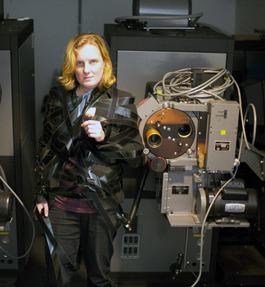home | north bay bohemian index | news | north bay | news article

Photograph by Elizabeth Seward
END CREDITS: Film projectionists like the Roxy Theater's Bonnie Zaft are finding their expertise replaced by hard drives.
The Last Reel
As theaters convert to digital, film projectionists become a dying breed
By Blake Montgomery
Walking into the projection booth of Santa Rosa's Roxy Theater, reels of film, cans of WD-40 and specialty tools litter the workspace. Projectors hum comfortably while 35mm film flaps through the pulleys and onto giant platters. Scissors, tape and splicing mechanisms sit amid clippings of film at a nearby desk.
But soon, this will all be gone. This is the last day the Roxy is showing film. By press time, all the film projectors will havebeen replaced by digital projectors, screening content from hard drives.
"I've been fighting it for a long time," says Bonnie Zaft, the Roxy's head projectionist, walking past giant reels of film, the theater's last. "But at some point, you have to embrace change."
Zaft has been working with film for 18 years, and is known in local theater circles as one of the best film projector technicians around. But like so many other projectionists across the country, she'll soon find her skill set obsolete.
The conversion from film to digital projection is part of a nationwide trend. Warner Bros., 20th Century Fox and Paramount all began delivering movies on digital hard drives years ago, slowly phasing out bulky, heavy film containers and their high shipping costs.
"When the three major studios went digital, it was only a matter of time until they stopped shipping prints altogether," Zaft says. Studios still send film prints to theaters that haven't upgraded yet, but most everyone agrees that it's only a matter of time before they stop making film entirely, with some estimates as soon as three years from now.
The Roxy isn't the first local theater to convert to digital projection. Theaters in Sonoma, Petaluma, Sebastopol and Fairfax, owned by Cinema West, all use digital exclusively.
More common is a mix of both film and digital. The Smith Rafael Film Center still maintains film projectors for about half its theaters. Richard Peterson, director of programming, sees film as a diversifying agent for the theater.
"Film has been around for a hundred years," Peterson explains. "And if I want to show a movie from the 1940s that hasn't been digitized, the only way I can do that is on 35mm. The theaters that only want to show new movies will have to go digital, but we're going to keep showing old ones."
As with any analog-digital debate, aesthetics are an issue as well. "I think film looks better. A lot of people disagree with me," Zaft says. "But if you stand about halfway in the theater, you can see little pixels on the screen."
But environmentally, digital projection makes sense. A two-hour movie requires about 11,000 feet of film—film that's created using dwindling silver and oil resources. Recycling the film requires a complicated process that few studios use. Hard drives, while using more heavy metals than film, can hold new content and are recycled more easily, though they're not as easily repaired if something goes awry.
"If we have a problem with the digital projector, we turn it off, turn it back on," Zaft says. "If that doesn't work, it's a bad part—we have to wait weeks. For the film projectors, you could usually shove something in there and get it running."
Economically, the shift is much more favorable for the studios. To produce an 80-minute movie on film, it costs the studio between $1,500 and $2,500, whereas a hard drive costs a fraction of that. Shipping costs are also significantly lowered. For a theater, however, implementing the digital apparatus can cost up to $150,000. That could leave smaller one-screen theaters struggling if and when studios abandon film altogether.
Admittedly, though, film has its complications.
"On Christmas Eve, an assistant dropped a three-hour movie on the ground, and it was just everywhere," Zaft illustrates by tugging at a now-defunct reel of film on the repair tables. "It took us about four or five hours to put it back together. So, yeah, if somebody drops the movie, and you have to put it back together, that's the worst," says Zaft, working at the central controlling computer for the new digital projectors. "That said, I've been trying to load Cars 2 for four hours today."
All in all, Zaft misses the familiarity of the whirring reel.
"Downstairs in the projection room, you can't hear anything," she describes. "The actual projector itself makes no noise. It's really creepy."
|
|
|
|
|
|